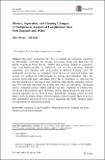Files in this item
Divorce, separation, and housing changes : a multiprocess analysis of longitudinal data from England and Wales
Item metadata
| dc.contributor.author | Mikolai, Julia | |
| dc.contributor.author | Kulu, Hill | |
| dc.date.accessioned | 2018-01-11T12:30:07Z | |
| dc.date.available | 2018-01-11T12:30:07Z | |
| dc.date.issued | 2018-02 | |
| dc.identifier | 250757386 | |
| dc.identifier | f6d6875b-161d-4e67-9825-23580aef35ef | |
| dc.identifier | 85040348579 | |
| dc.identifier | 000426300600004 | |
| dc.identifier.citation | Mikolai , J & Kulu , H 2018 , ' Divorce, separation, and housing changes : a multiprocess analysis of longitudinal data from England and Wales ' , Demography , vol. 55 , no. 1 , pp. 83-106 . https://doi.org/10.1007/s13524-017-0640-9 | en |
| dc.identifier.issn | 0070-3370 | |
| dc.identifier.other | ORCID: /0000-0002-7733-6659/work/48516892 | |
| dc.identifier.other | ORCID: /0000-0001-8808-0719/work/75996988 | |
| dc.identifier.uri | https://hdl.handle.net/10023/12465 | |
| dc.description | The study was supported by the Economic and Social Research Council (ESRC, grant no. ES/L01663X/1). | en |
| dc.description.abstract | This study investigates the effect of marital and non-marital separation on individuals’ residential and housing trajectories. Using rich data from the British Household Panel Survey (BHPS) and applying multi-level competing-risks event history models, we analyze the risk of a move of single, married, cohabiting, and separated men and women to different housing types. We distinguish between moves due to separation and moves of separated people and account for unobserved co-determinants of moving and separation risks. Our analysis shows that many individuals move due to separation, as expected, but the likelihood of moving is also relatively high among separated individuals. We find that separation has a long-term effect on individuals’ residential careers. Separated women exhibit high moving risks regardless of whether they moved out of the joint home upon separation whereas separated men who did not move out upon separation are less likely to move. Interestingly, separated women are most likely to move to terraced houses, whereas separated men are equally likely to move to flats and terraced houses, suggesting that family structure shapes moving patterns of separated individuals. | |
| dc.format.extent | 24 | |
| dc.format.extent | 1746348 | |
| dc.language.iso | eng | |
| dc.relation.ispartof | Demography | en |
| dc.subject | Separation | en |
| dc.subject | Long-term effect | en |
| dc.subject | Housing transitions | en |
| dc.subject | England and Wales | en |
| dc.subject | Multi-level event history analysis | en |
| dc.subject | G Geography (General) | en |
| dc.subject | H Social Sciences (General) | en |
| dc.subject | HQ The family. Marriage. Woman | en |
| dc.subject | 3rd-DAS | en |
| dc.subject | BDC | en |
| dc.subject | R2C | en |
| dc.subject.lcc | G1 | en |
| dc.subject.lcc | H1 | en |
| dc.subject.lcc | HQ | en |
| dc.title | Divorce, separation, and housing changes : a multiprocess analysis of longitudinal data from England and Wales | en |
| dc.type | Journal article | en |
| dc.contributor.sponsor | Economic & Social Research Council | en |
| dc.contributor.institution | University of St Andrews. School of Geography & Sustainable Development | en |
| dc.identifier.doi | 10.1007/s13524-017-0640-9 | |
| dc.description.status | Peer reviewed | en |
| dc.date.embargoedUntil | 2018-01-10 | |
| dc.identifier.grantnumber | ES/L01663X/2 | en |
This item appears in the following Collection(s)
Items in the St Andrews Research Repository are protected by copyright, with all rights reserved, unless otherwise indicated.

